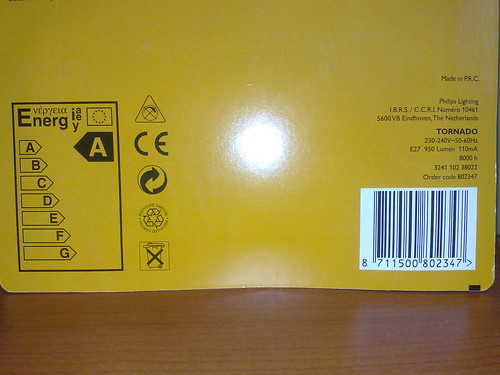I moved to Spain recently. Setting up a new home in a new country meant a lot of new purchases. I bought CFL (and some LCD) bulbs for lighting. That was easy.
However, when it came to other purchases, things were far from clear.
I wanted a Blu-Ray DVD player and a decent TV but how do I get information on the energy efficiency of these devices to compare them?
The Sony BDP-S300 Blu-Ray DVD player product page has no information whatsoever on the power requirements of the device (and that is one of the only reasonably good Blu-Ray players easily available here, for now).
Similarly with the TV. I know plasma screens use far more energy than LCD so I wanted an LCD but there is no site which allows you to compare the energy usage of different TVs (or DVD players, or computers, or printers or…) in the same way that the ActOnCO2 site does for cars, for instance.
What I really want though, and I suspect I am not alone in this, is clear certified energy labels on all electrical items, similar to the ones on the light bulb packaging above.
We already have energy labels for most white goods, light bulb packaging and cars in the EU, it should be possible to extend this to cover all electrical products. I understand that it is not straightforward but it would be incredibly useful for consumers and would reward responsible manufacturers.
So, why can’t we have standardised, energy labels for all electronic devices?


Hi,
Good point. There is no reason why it shouldn’t be done. Then we finally will know how energy efficient electronics have. As mentioned in my blog, even Europump, the European Association of Pump Manufacturers, has an Energy Efficiency Index to show how efficient their circulation pumps in central heating are.
Eddy
After reading your blog, I thought that you might be interested in HP’s work on an “Eco Label.” http://www.hp.com/hpinfo/globalcitizenship/environment/productdesign/ecohighlights-label.html
We will be rolling this out over time, and will eventually include most product categories in all divisions. Also looking for ideas on how to improve it.
We certainly need an easy to understand ratings system. I guess the work is in defining what an A or a D rating is for each item of equipment. If you set the A to high, manufacturers scramble to get to that level but there is no incentive to go further. An ambitious target is better, but meets more resistance from the manufacturers.
Reading your post I was reminded of the Minergie standard for buildings that was developed in Switzerland, originally by an individual but is now run as a company. Maybe there is room to do something similar with appliances. Once we have cheap measuring equipment we can share how much our Blue Ray DVD costs to run compared to yours.
Bob,
thanks for the link – I checked out the label and I think it is a nice idea, however, what would be great is if the CO2 emissions associated with production, usage and end of life were displayed prominently.
We want quantitative, standard (easily comparable) labels to help us reach a purchasing decision.
Anything else is smacks of obfuscation.